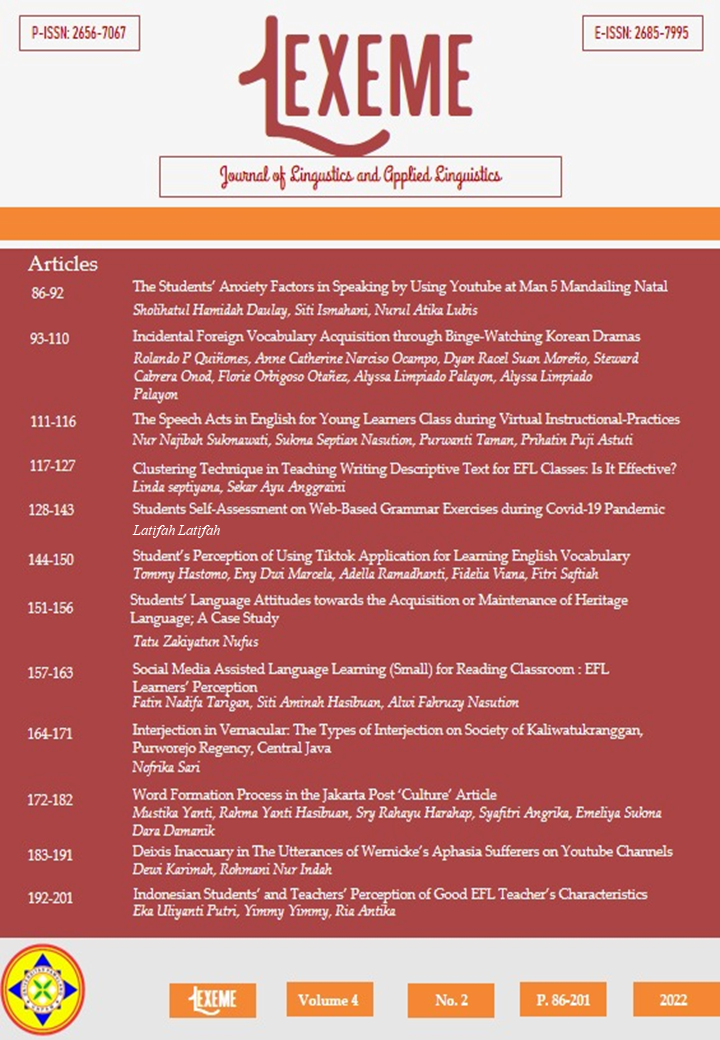STUDENTS SELF-ASSESSMENT ON WEB-BASED GRAMMAR EXERCISES DURING COVID-19 PANDEMIC
DOI:
https://doi.org/10.32493/ljlal.v4i2.20490Keywords:
grammar exercise, self-assessment, students’ perception, web-based learningAbstract
The higher education community got significant challenges due to the raised of the Covid-19 pandemic around the globe. A full teaching and learning online has to be taken as the urgent alternation of the face-to-face university courses. Therefore, this research points at describing the advantages of using web-based learning and the students’ perceptions towards the techniques used. Furthermore, this research also aims to know the students ability to do self-assessment by using web-based exercises. The students’ grammar understanding would also be described in this research. Descriptive design was applied as the method to describe the students’ self-assessment in grammar web-based exercise. The data taken are quantitative and qualitative. Students’ perceptions are taken as qualitative data and the students’ grammar achievements are taken as the quantitative data. Thirty students of Advanced Grammar class are chosen as the data source. There are two instruments used in this research. They are the students’ grammar scores from web-based exercise and the questionnaire of students’ perception in grammar web-based exercise. The data are collected after the grammar class term ended. The research found that there are 55% of the students with their grammar mastery for the first half semester. However, there are 82, 8% of students that have a learning grammar mastery at the second half semester. It indicates that using web-based grammar exercise in teaching grammar can improve students’ achievement and mastery in learning grammar.
References
Amua-Sekyi, Ekua Tekyiwa. (2016). Assessment, Student Learning and Classroom Practice: A Review. Journal of Education and Practice www.iiste.org. ISSN 2222-1735 (paper) ISSN 2222288X (online) Vol. 7, No.21, 2016
Anderson, Gary. (2005). Fundamental of Educational Research. London: Taylor and Francis Library.
Ary, Donald., Jacobs, Lucy Cheser., & Sorensen,Chris. (2010). Introduction to Research Education. Belmont: Wadsworth, Cengage Learning
Baturay, Meltem Huri, et all. (2010). Language Practice with Multimedia Supported Web-based Grammar Revision Material. European Association for Computer Assisted Language Learning. ReCALL 22(3): 313-331.
Biggs, J. (2003). Teaching for quality learning at university. Berkshire: Open University Press.
Brown, D. H. (1990). Language assessment: Principles and classroom practices. London: Longman
Can, T. (2009). Learning and teaching languages online: A constructivist approach. Novitas-ROYAL 3(1), 60-74.
Cleophas, Francois. (2020). Covid-19 Pandemic Highlights Challenges of Online Teaching and Learning. The Mail & Guardian. Retrieved November 29, 2020 at 2:46 p.m. form Covid-19 pandemic highlights challenges of online teaching and learning - The Mail & Guardian (mg.co.za)
Crawford, J., et all. (2020). COVID-19: 20 countries' higher education intra-period digital pedagogy responses. Journal of Applied Teaching and Learning (JALT), 3(1).
Dalgarno, B. & Lee, M. J. W. (2010). What are the learning affordances of 3-D virtual environments? British Journal of Educational Technology 41(1), 10-32.
Gay, L.R., Mills, Geoffrey E., & Airasian, Peter. W., (2012) Educational Research; Competencies a for Analysis and Aplications. Boston: Pearson
Harmer, Jeremy. (2007). How to Teach English. Harlow: Pearson Education Limited.
Henderson, M., H. Huang, S. Grant & L. Henderson. (2009). Language acquisition in Second Life: Improving selfefficacy beliefs. Paper presented at ASCILITE Auckland, New Zealand. Retrieved April 10, 2012, from http://newmediaresearch.educ.monash.edu.au/moodle/file.php/2/publications/henderson_ascilite_2009.pdf
Hegelheimer, Volker, & Fisher, David (2006) Grammar, Writing and Technology: A Sample Technology-Supported Approach to Teaching Grammar and Improving Writing for ESL Learners. CALICO Journal 23 (2). p-p 257-279
Karim, Rafidah Abd. (2011). The Effectiveness of Web-based Instruction and Students?Attitude toward Learning Basic English Grammar. International Conference on Teaching and Learning Education (ICTLE).
Kaur, G. (2020). Digital Life: Boon or bane in teaching sector on COVID-19. CLIO an Annual Interdisciplinary Journal of History, 6(6), 416-427.
Mailizar, Almanthari, A., et all. (2020). Secondary school mathematics teachers’ views on elearning implementation barriers during the Covid-19 pandemic: The case of Indonesia Eurasia Journal of Mathematics, Science and Technology Education, 16(7), em1860.
Moqbel, M. S. S., (2018). Self–assessment in EFL grammar classroom: A study of EFL learners at the Centre for Languages and Translation, Ibb University. International Journal for Research in Education, vol. 42(2), pp. 288-324.
Nam and Smith. (2007). Web-Based Learning Environment: A Theory-Based Design Process for Development and Evaluation. Journal of Information Technology Education Vol. 6, 2007
Pacheco, Allen Quesada. (2005). Web-Based Learning (WBL): A challenge for foreign language teachers. Revista Electrónica "Actualidades Investigativas en Educación", vol. 5, núm. 2, juliodiciembre, 2005, pp. 1-25
Rahayu, Intan Sinta Dewi & Pupung Purnawarman. (2018). The Use of Quizizz in Improving Students’ Grammar Understanding through Self-Assessment. Advances in Social Science, Education and Humanities Research, volume 254, p. 102-106. Atlantis Press.
Rapanta, et all. (2020). Online University Teaching During and After the Covid-19 Crisis: Refocusing Teacher Presence and Learning Activity. Postdigital Science and Education Vol. 2, pages 923-945 (2020)
Scot Thornbury, (2019). How to Teach Grammar. Pearson Education Limited. Harlow England
Sinaga, Octovany. (2018). Students’ Perception on the Role of English Day Program in Speaking Skill Development. Journal of English Teaching. Vol. 4, No. 2 June 2018. ISSN 2087 9628.
Slameto. (2010). Belajar dan Faktor-Faktor yang Mempengaruhinya. Jakarta: Rineka Cipta
Sobkowiak, W. (2011). “Happiness I hadn’t felt beforeâ€, czyli nauka j?zyków obcych w drugim ?yciu. In: M. Pawlak & B. Wolski (Eds.), Wykorzystanie nowoczesnych technologii w dydaktyce j?zyków obcych (pp. 123-130). Konin: Wydawnictwo UAM i PWSZ w Koninie.
Son, J-B. 2007. Learners Experiences in Web-Based Language Learning. Computer Assited Language Learning, 20(1), 21-36.
Toquero, C. M. (2020). Challenges and opportunities for higher education amid the COVID-19 pandemic: The Philippine context. Pedagogical Research, 5(4).
Tuan, Nguyen. (2015). The Effectiveness of Online Learning: Beyond No Significant Difference and Future Horizons. MERLOT Journal of Online Learning and Teaching. Vol. 11, No.2, June 2015.
Wang, T., Web-based quiz-game-like formative assessment: Development and evaluation. Computers and Education, vol. 51(3), pp. 1247-1263. 2008.
Weleschuk, Ashley., Djyur, Patti., & Kelly, Patrick (2019). Online Assessment in Higher Education. Calgary: Taylor Institute for Teaching and Learning 434 Collegiate Blvd
Yin, Robert K.2011.Qualitative Research from Start to Finish. New York: The Guilford Press.
Ying, Li & Liping, Chen (2016). Peer- and self-assessment: A Case Study to Improve the Students’ Learning Ability. Journal of Language Teaching and Research, Vol. 7, No. 4, pp. 780-787, July 2016 DOI: http://dx.doi.org/10.17507/jltr.0704.20
Downloads
Published
How to Cite
Issue
Section
License
Copyright (c) 2022 Wiwit - Sariasih, Latifah - -

This work is licensed under a Creative Commons Attribution-ShareAlike 4.0 International License.







